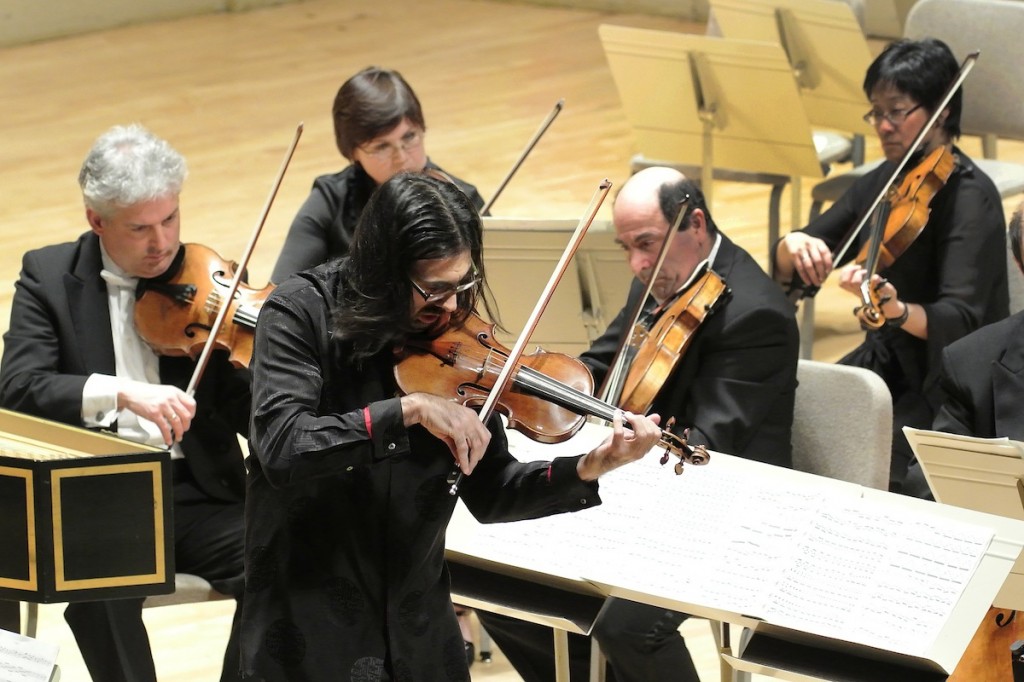Violinist Kavakos does double duty with BSO in energetic program

Violinist-conductor Leonidas Kavakos performed a Bach concerto Tuesday night with the BSO. Photo: Stu Rosner
Maybe the Boston Symphony Orchestra should consider hiring violinists to lead it from now on.
The current BSO season, plagued with several conductor cancellations, began memorably and auspiciously with Anne-Sophie Mutter playing and leading Mozart’s five violin concertos. And on Tuesday night, Leonidas Kavakos showed up as advertised to play and lead a Bach concerto, then conduct energetic performances of works by Lutoslawski and Beethoven. Fiddle players just live right, it seems.
Long-haired, loose-limbed, and attired in a black-on-black polka-dotted evening jacket, Kavakos cut a somewhat whimsical figure onstage, but that took nothing away from the virtuoso fire he lit under Bach’s Concerto in D minor, BWV 1052. If you thought that piece was a piano concerto, you’re right—Bach’s well-known keyboard work is thought to have been adapted from an earlier violin concerto, which was reconstructed for the New Bach Edition in 1970.
In the violin version, the first movement’s solo episodes crackle with fast string-crossing figures and scales, and Vivaldi’s influence comes to the fore. On Tuesday, the Greek-born violinist and his handful of BSO string players got off to a somewhat shaky start, rushing through the brawny ritornello theme and not really establishing a firm tempo till midway through the movement, but eventually Kavakos’s fierce concentration in the episodes saved the day.
Kavakos took the central Adagio at almost a largo, his chaste, near-vibratoless tone evoking a Vivaldian frozen landscape. But fire blazed again in the closing Allegro, an exciting, headlong performance that often threatened to spin out of control, but never did.
Lutoslawski’s Musique funèbre for string orchestra, composed in 1954-58 and dedicated to the memory of Bartók, is one of this composer’s pivotal works, a 12-tone composition that emulates the Hungarian master’s transparency in form and handling of themes. Built from melodic cells consisting of minor seconds and tritones, its four connected movements describe an arc from exposition in the Prologue, variations-style development in the Metamorphoses, a fortissimo climax of 12-note chords in the Apogee, and a death-like disintegration in the Epilogue.
Kavakos’s unconventional podium technique had more than a touch of “air conductor” to it, as the crouching, leaping, swaying violinist-turned-maestro didn’t always resist the urge to illustrate every single event in the score with a gesture. His cheerleading was eloquent in its way, however, and he could hardly have been clearer about his beat and expressive intentions. The BSO string players responded with a taut, vibrant performance that dwindled in the end to nearly-inaudible phrases in a single cello, which Kavakos conducted with only the tiniest motions of his right wrist. Rarely has the tip of a baton been so closely watched by so many.
The program closed with a ripe rendition of Beethoven’s Symphony No. 4 in B-flat major, Op. 60. Swelling its ranks to fill the stage, the BSO rewarded Kavakos and the Symphony Hall audience with a rich orchestral sound to warm the hall’s chilly acoustics. In the context of this composer’s symphonies, the Fourth’s mysterious opening Adagio is the “What will he do for an encore?” moment following its trailblazing predecessor, the Eroica. Kavakos drew out the suspense as long as possible before pouncing delightedly on the answer, a boisterous Allegro vivace.
For the Adagio, Kavakos laid down his baton and conducted with sinuous arm and finger gestures, seemingly to counteract, or at least soften, the movement’s persistent tick-tock rhythm. The orchestra responded, however, with a rather cool, objective rendition of the movement, its metronomic character intact. The scherzo also charged ahead through its Allegro vivace and (potentially) more expansive trio sections, but here the orchestra and the ebullient conductor seemed at least to be on the same page.
Beethoven marked the finale, with its bustling sixteenth notes, Allegro ma non troppo—fast, but not too fast. Once again, Kavakos pushed the tempo without quite crossing the line. (bassoonist Richard Svoboda and the double-bass section might disagree). In the end, the conductor’s evident delight in the race car he’d been given to drive proved infectious for all present.
The program will be repeated 8 p.m. Thursday, 1:30 p.m. Friday and 8 p.m. Saturday. bso.org; 617-266-1200.
Posted in Performances
Posted Apr 01, 2012 at 10:25 am by Peter Gravel
My partner and I had our first ever experience at Symhony Hall to hear this performance on Sat. March 31,2012.
As an introduction to not only this magnificent hall, the amazing Boston Symphany Orchestra, and the music performed I could no have asked for better.
Thanks to all performers, staff.
Peter R Gravel, Elisabeth Gold
Halifax, Nova Scotia, Canada